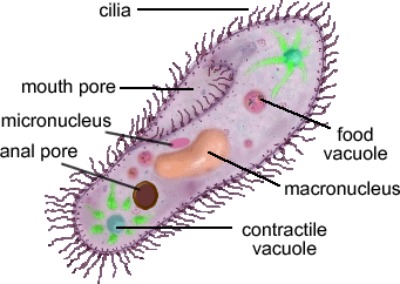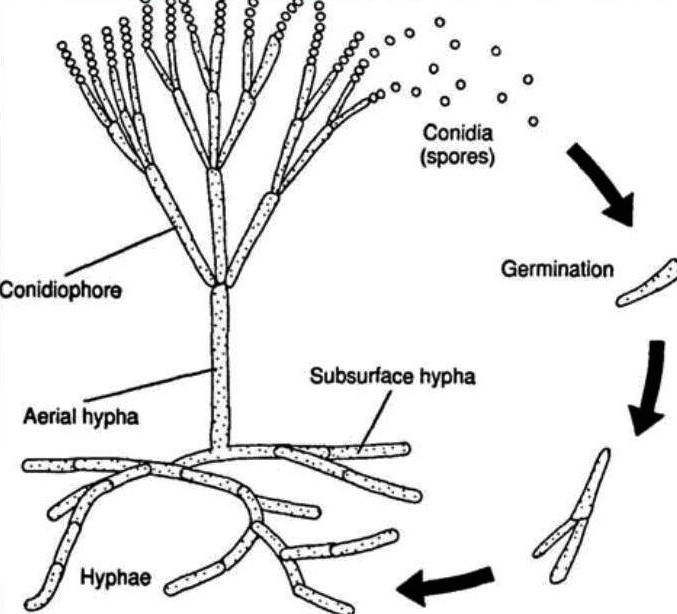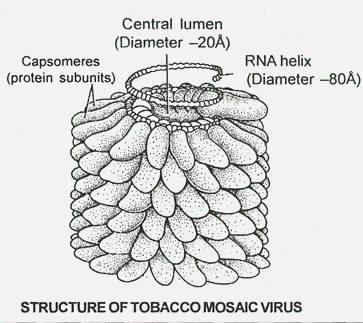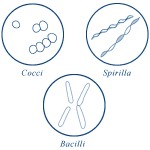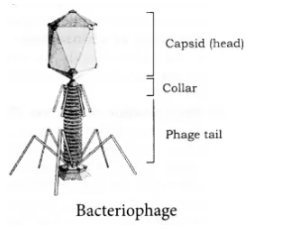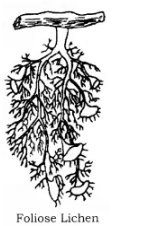Biological Classification - Class 11 Medical Biology - Extra Questions
Which do you think is a more basic characteristic for classifying organism ?
(a) The place they live
(b) The kind of cells they are made of. Why?
Why are the classification systems changing every now and then?
What do the terms phycobiont and mycobiont signify?
Short / Long answer type questions.
What are (a) methanogens, (b) halophiles, and (c) themoacidophiles?
How is archaebacteria different from eubacteria.
Match the terms to these definitions.
Conjugation, transformation, transduction, phototrophs, saprotrophs, archaebacteria, actinomycetes, mycoplasma, thermoacidophiles, methanogens, halophiles, vibrio, Bacillus, micrococcus, helical, staphylococcus.
.......... characterised by possessing cell walls without peptidoglycan, a substance found in the walls of eubacteria.
Differentiate between.
Halophiles and thermoacidophiles.
Match the terms to these definitions.
Conjugation, transformation, transduction, phototrophs, saprotrophs, archaebacteria, actinomycetes, mycoplasma, thermoacidophiles, methanogens, halophiles, vibrio, Bacillus, micrococcus, helical, staphylococcus.
.......... a kind of archaebacteria, found in hot sulphur springs.
Fill in the blanks with approprite words.
.......... is a method of sexual reproduction where two hyphae meet together.
Fill in the blanks with approprite words.
A thick-strand of underground hyphae resembling a root is known as..........
Very short answer type.
Observe the relationship between the first two words and then fill in the fourth place
moss : capsule , fern : ______
What is a Lichen?
Short / Long answer type questions.
How do the archae differ from the bacteria?
What is the smallest Pathogen?
How did Whittaker classify the organisms? What was the basis for classification?
Match the terms to these definitions.
Ascus, mycelium, basidium, mycorrhiza, budding, conidiospore, rhizomorph, stroma, fruiting body, sporangium, fungus, hypha, spore, lichen, zygospore, apothecium.
..........A symbiotic association between a fungus and an alga, may live in stressful environment
What are (i) methanogens (ii) Halophiles (iii) thermoacidophiles?
Very short answer type.
Name the three sub-kingdoms of Protista as proposed by Robert H. Whittaker.
In which kingdom are viruses placed?
Five kingdom classification of living organisms is given by ..........
Why is the virus called a mysterious microbe?
________ bacteria are microbes that work in the absence of oxygen.
The cell walls in most fungi contain ________
Unlike plant cell walls which are made of cellulose, most bacterial cell walls contain ...........
Short / Long answer type questions.
Describe briefly various methods of reproduction in bacteria and also the mechanism of transformation.
What are viruses? How do they differ from other microbes?
The given organism grows on a bread and commonly known as_______.
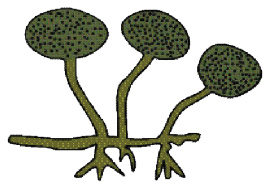
Name the microorganism.
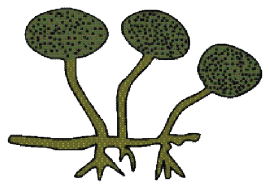
Why are the protozoan placed in kingdom Protista and not in kingdom Animalia?
What are haustoria?
State two economically important uses of : (a) Heterotrophic bacteria(b) Archaebacteria
Bacteria cannot be seen with the naked eyes, but these can be seen with the help of a microscope. If you have to carry a sample from your home to your biology laboratory to demonstrate the presence of microbes under a microscope, which sample would you carry and why?
Which organisms act as an interlink between living and non-living organisms? Why do you think so?
What was the basis of early classifications?
Write the characteristics features of poxviruses.
List any two living characteristics of virus.
Viruses can be crystallized. What does this signify?
List out the differences between enveloped virus and naked virus.
The storage products of fungi are __________ and __________.
Fungi do not possess chlorophyll. Hence they are incapable of photosynthesis.So, they depend on either living organisms or non-living things. Name the two types of modes of nutrition in fungi.
Viruses can undergo mutation. What does this signify?
________ isolated first virus in crystalline form.
Name the three domains according to the modern classification proposed by C.Woese, O.Kandler and M.C.Wheelis.
Describe the structure of a typical protist.
What do you mean by archaebacteria?
Which protist causes Leucorrhoea?
What is organisation ?
Name a moneran which shows pendulum like movements.
Who proposed the term Protista?
What is heterothalism? Give its importance.
In what respect do you consider bacteria as simple organisms?
Name the protein coat which surrounds the nucleic acid core of a virus.
Name the three kingdoms of Archaea.
Classification reflects phylogeny when the hierarchy of groups reflects their ...........
What is the the basic unit of classification?
How would you distinguish Archaea from Eubacteria?
Enumerate the criteria used by Whittaker (1969) for classification of organisms.
What type of organisms were included in Kingdom Animalia by Whittaker (1969) in his Five Kingdom system of classification?
Whittaker classified organisms on the basis of:
Match the term to these definitions.
UNDERSTANDING THE TERMS
Taxonomy, Classification, Phylogeny, Phylogenetic tree, Taxon, Homology, Analogy, Cladistics, Nomendature, Archaea, Fungi, Protista
.......... characterised by possessing cell walls without peptidoglycans.
Short / Long answer type questions.
Describe in brief the economic importance of bacteria.
Name the three groups into which Archaebacteria has been categorised.
Methanogens have a unique form of energy metabolism in which .......... is used to reduce......…. to ..........
Name a disease of human beings caused by prions.
How does Penicillium reproduce asexually?
Name the genus to which baculoviruses belong. Describe their role in integrated pest management programmes.
Mention the role of Methanobacterium in rumen of cattle
Give a brief account on the need of classification?
Majority of lichens are made of
Give the general characters of viruses.
Discuss how the classification system has undergone several changes over a period of time?
Brief about Aristotle's classification?
What are thermophiles?
Define dueterolichens with examples.
What were the limitations of five kingdom classification?
State the merits of Whittaker's method of classification.
Give a brief account on TMV.
What are the different types of lichen based on their external forms?
Describe the given picture.
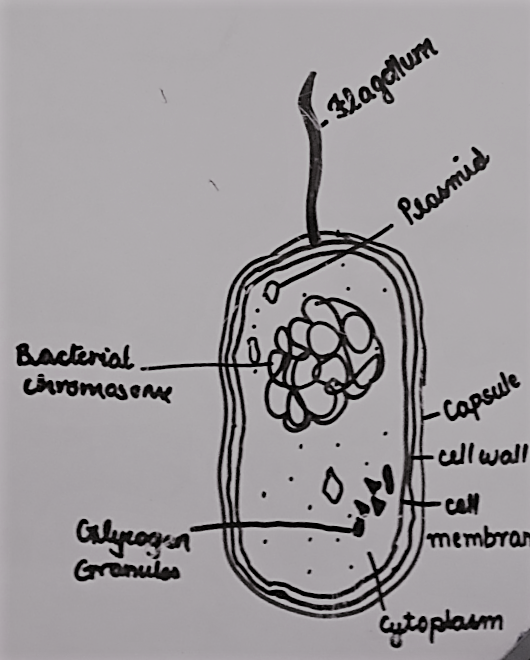
Which do you think is a more basic characteristic for classifying organisms?
(a) The place where they live.
(b) The kind of cells they are made of. Why?
(b) The kind of cells they are made of. Why?
Justify that Lichens are pioneer organisms.
Complete the statements with a proper option from the list given below.
(mycotoxins, budding, rhizobium)
Toxins of fungal origin are called _______.
As a fungus completes its life cycle on two hosts, it is termed as
Most abundant bacteria are
In the hierarchy of classification, which group will have the smallest number of organisms with a maximum number of characteristics and which group will have the largest number of organism?
Who coined term virus?
Explain bacillus.
What is the basis for classification?
'Classification of life forms is closely related to their evolution.' Do you agree with this statement? Comment with an example.
How nucleopolyhedroviruses are used in these days?
List any 3 characteristic's of fungi.
Write two precautions you take, while observing Rhizopus in the laboratory.
Kingdom Fungi have cell wall, but still it cannot be classified under Plantae? Give any two reason.
Write any two places where methanogens can be found.
It is necessary to give scientific names to the organisms. Give scientific reason.
In Rhizopus, tubular thread-like structures bearing sporangia at their tips are called:
A. filaments
B. hyphae
C. Rhizoids
D. roots
Fungi do not contain _____.
Explain the criteria for grouping of organisms into five major kingdoms.
Pick incorrect statement/s:A. Protista includes unicellular eukaryotic organisms
B. Whittaker considered cell structure, mode and source of nutrition for classifying the organisms into five kingdoms
C. Monerans have well-defined nucleus
A fungus ______ can be seen without microscope.
Basic smallest unit of classification is __________
What observable features in Trypanosoma would make you classify it under kingdom Protista?
Explain Symbiosis in Lichens?
In the five-kingdom system of Whittaker, how many kingdoms are eukaryotes?
Who am I? I live on dead and decaying organic matter.
Explain the structure of virus? Draw a labelled diagram of Bactereriophage
Write short notes on:
Lichen.
What are viruses? Why do they not show any characteristics of life?
Who proposed the five kingdom classification?
Following are a few organisms
(a) lichen (b) mosses (c) mango tree (d) cactus
Which among the above can grow on stones; and also help in formation of soil? Write the mode of their action for making soil.
If there are two pathogenic viruses, one with DNA and other with RNA, which would mutate faster? And Why?
Give an example of a rod-shaped virus.
What is the common method of reproduction in bacteria?
What for Nucleopolyhydro viruses are being used now-a-days?
Long Answer.
Lichen is usually cited as an example of 'symbiosis' in plants where an algal and a fungal species live together for their mutual benefit. Which of the following will happen if algal and fungal partners are separated from each other?
(a) Both will survive and grow normally and independently from each other.
(b) Both will die
(c) Algal component will survive while the fungal component will die.
(d) The fungal component will survive while the algal partner will die.
Based on your answer how do you justify this association as symbiosis
Lichen is usually cited as an example of 'symbiosis' in plants where an algal and a fungal species live together for their mutual benefit. Which of the following will happen if algal and fungal partners are separated from each other?
(a) Both will survive and grow normally and independently from each other.
(b) Both will die
(c) Algal component will survive while the fungal component will die.
(d) The fungal component will survive while the algal partner will die.
Based on your answer how do you justify this association as symbiosis
Identify and state the type of reproduction represented in the above figure.
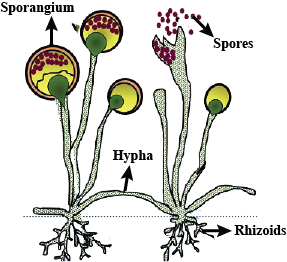
In the following figure, explain how new fungal colonies of Mucor are formed:
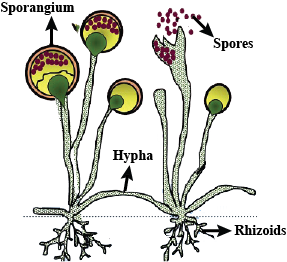
Kingdom Monera includes the most ..........1.........., the ..........2.........., the simplest and the most plentiful ..........3........... These organisms are most ..........4........... They were the first ..........5.......... of the earth, and they still ..........6.......... to flourish. Carl Woese (1994) has ..........7.......... kingdom Monera into Archaebacteria and ..........8........... These ..........9.......... are mostly unicellular. The ...........10........... are, however, ..........11.......... They do not have a ..........12.......... nucleus. The genetic material is a ..........13.......... double-stranded, ..........14.......... (Deoxyribonucleic acid) not enclosed by a ..........15.......... Such organisms which do not have a ..........16.......... are called prokaryotic.
Discuss how classification systems have undergone several changes over a period of time?
Define nucleocapsid.
Write a note on "significance of viruses".
Make an outline of the classification. What are the advantages and disadvantage of this classification?
Highlight the criteria used for five kingdom system of classification.
Discuss the types of reproduction in Kingdom Mycota with examples
Complete the chart.
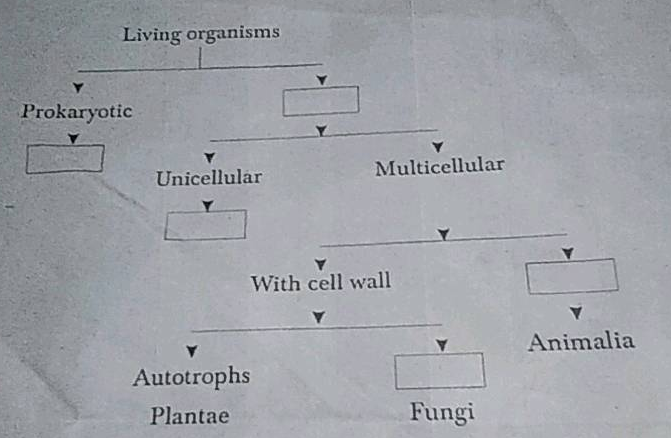
Sporangiospores are formed in sporangium. The fungal filament on which sporangium is formed is called as
Class 11 Medical Biology Extra Questions
- Anatomy Of Flowering Plants Extra Questions
- Animal Kingdom Extra Questions
- Biological Classification Extra Questions
- Biomolecules Extra Questions
- Body Fluids And Circulation Extra Questions
- Breathing And Exchange Of Gases Extra Questions
- Cell Cycle And Cell Division Extra Questions
- Cell The Unit Of Life Extra Questions
- Chemical Coordination And Integration Extra Questions
- Digestion And Absorption Extra Questions
- Excretory Products And Their Elimination Extra Questions
- Locomotion And Movement Extra Questions
- Mineral Nutrition Extra Questions
- Morphology Of Flowering Plants Extra Questions
- Neural Control And Coordination Extra Questions
- Photosynthesis In Higher Plants Extra Questions
- Plant Growth And Development Extra Questions
- Plant Kingdom Extra Questions
- Respiration In Plants Extra Questions
- Structural Organisation In Animals Extra Questions
- The Living World Extra Questions
- Transport In Plants Extra Questions
